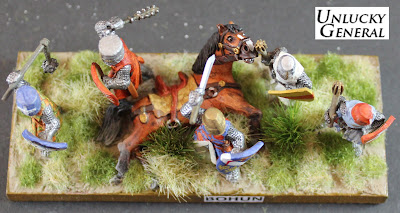Richard de Grey's Company: Centre Ward Foot
Richard de Grey, knight of Codnor was the son of Henry de Grey and
Isolda Bardolf. The Grey family’s principle estate held by the senior members
of the de Grey family was Codnor in Derbyshire. Before continuing, as with many
persons in the historical record there exists on the Internet a deal of
confusion concerning lineages and there exists contradictory material on
Richard. It remains unclear to be when my Richard was born and his age at
Lewes, there being a good deal of suggestion that he was quite elderly at the
time but I suspect on-line details of his life confuse this Richard with his immediate
predecessor. I have relied on the tried and true websites such as The Peerage
and the published works on the Barons War and Battle of Lewes. The details
given, whilst not complete, are at least those I remain confident of.
 |
| What's left of Codnor Castle today |
 |
| Derbyshire |
As custos of Dover castle, he and his men refused the King entry into England in December 1263 and in 1264. Richard was an active rebel and moved to take part in the third siege of Rochester (April 1264). There is doubt about Richard Grey’s presence at Lewes – his having been recorded as returning to Dover when the Rochester siege was lifted. He was a man intent on being at the centre of the action and whilst later made custos of Rochester castle during the Montfortian ascendancy, he was with the surrendering rebels when Kenilworth fell in 1266.
Accepting the terms of the dictum de Kenilworth, Richard was taken prisoner and his lands confiscated; however, these were restored to him some time later. Richard died no later than 1271 most probably of natural causes, having survived the war.
I have placed Richard at Lewes for the purposes of my reconstruction in command of a body of foot in the central ward of the rebel army under the immediate command of Gilbert de Clare. I have selected a knight with an older fashioned kettle helm from the Gripping Beast range. I hedged my bets over the man's vintage instead of opting for an enclosed great helm which would have been more the fashion for a younger man. It's more probably practical for commanding foot for hearing, seeing and issuing commands. The remainder of the company is made up of Kingmaker, Gripping Beast, Essex and Mirliton figures. Whilst several figures have padded armour, this will perform as an essentially unarmoured body of spear.
.JPG)




Comments
Jason
cheers
Matt